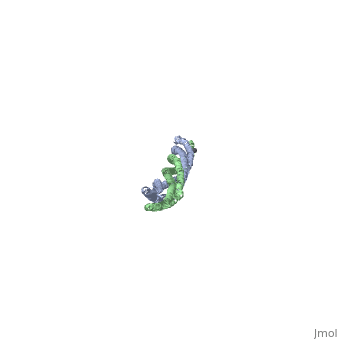2ch7
From Proteopedia
Crystal structure of the cytoplasmic domain of a bacterial chemoreceptor from Thermotoga maritima
Structural highlights
FunctionMCP2_THEMA Chemotactic-signal transducers respond to changes in the concentration of attractants and repellents in the environment, transduce a signal from the outside to the inside of the cell, and facilitate sensory adaptation through the variation of the level of methylation. Evolutionary ConservationCheck, as determined by ConSurfDB. You may read the explanation of the method and the full data available from ConSurf. Publication Abstract from PubMedIn bacterial chemotaxis, an assembly of transmembrane receptors, the CheA histidine kinase and the adaptor protein CheW processes environmental stimuli to regulate motility. The structure of a Thermotoga maritima receptor cytoplasmic domain defines CheA interaction regions and metal ion-coordinating charge centers that undergo chemical modification to tune receptor response. Dimeric CheA-CheW, defined by crystallography and pulsed ESR, positions two CheWs to form a cleft that is lined with residues important for receptor interactions and sized to clamp one receptor dimer. CheW residues involved in kinase activation map to interfaces that orient the CheW clamps. CheA regulatory domains associate in crystals through conserved hydrophobic surfaces. Such CheA self-contacts align the CheW receptor clamps for binding receptor tips. Linking layers of ternary complexes with close-packed receptors generates a lattice with reasonable component ratios, cooperative interactions among receptors and accessible sites for modification enzymes. Reconstruction of the chemotaxis receptor-kinase assembly.,Park SY, Borbat PP, Gonzalez-Bonet G, Bhatnagar J, Pollard AM, Freed JH, Bilwes AM, Crane BR Nat Struct Mol Biol. 2006 May;13(5):400-7. Epub 2006 Apr 23. PMID:16622408[1] From MEDLINE®/PubMed®, a database of the U.S. National Library of Medicine. See AlsoReferences
| ||||||||||||||||||||


